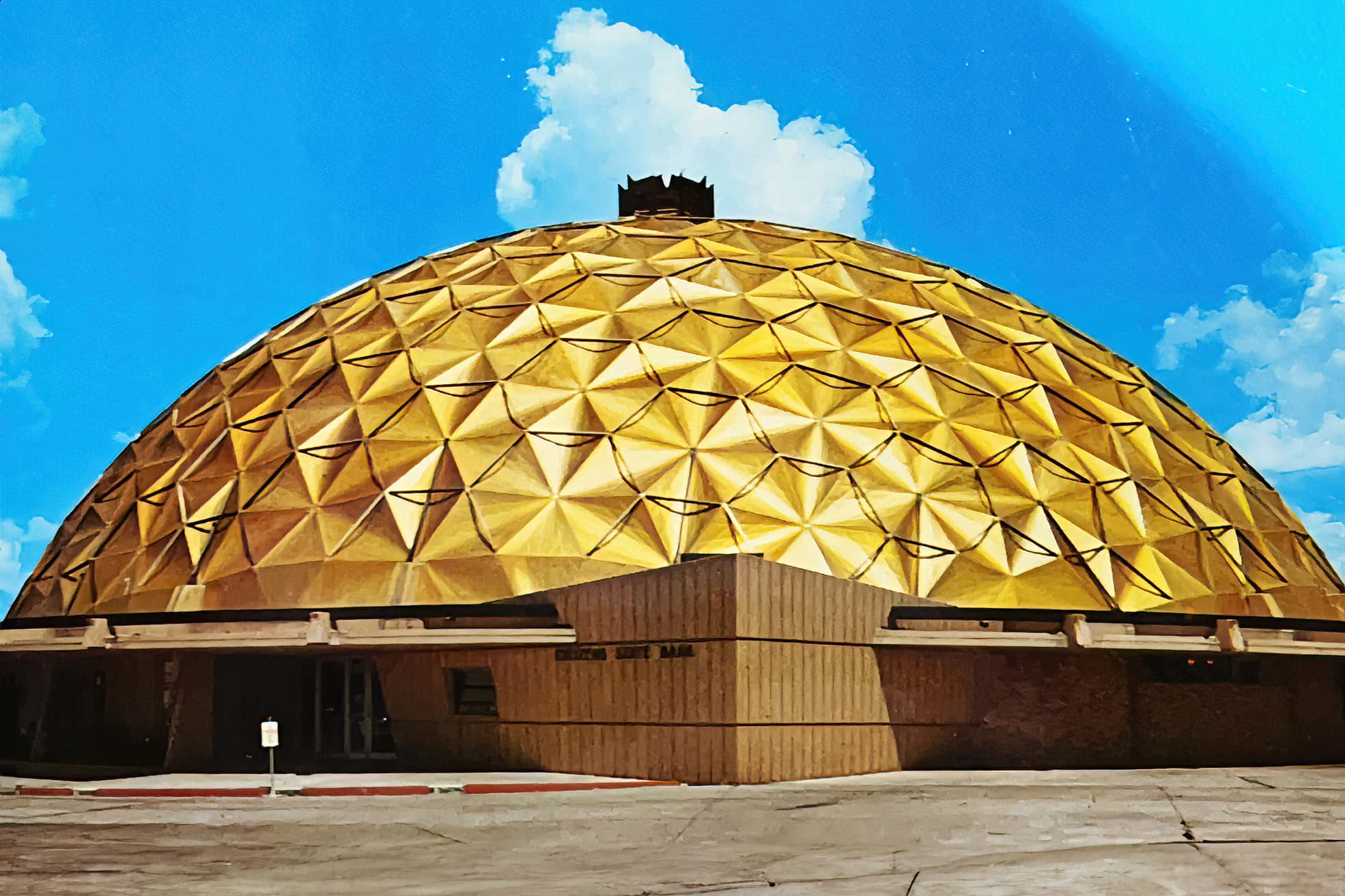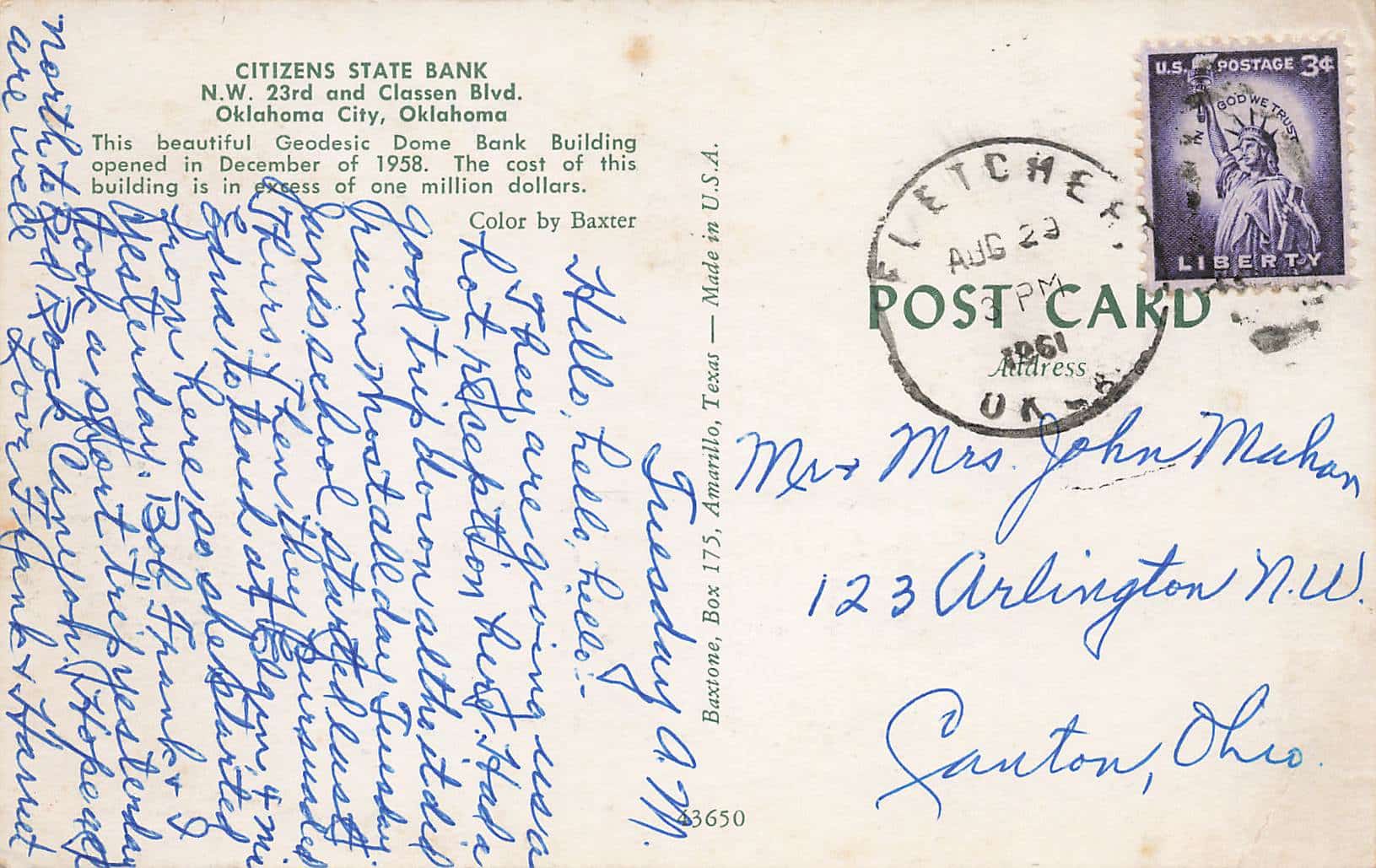
Gold Dome Bank | Oklahoma City Historical Postcards
From my Oklahoma City postcard collection…
The Gold Dome Bank, a notable landmark in Oklahoma City, stands as a testament to innovative design and engineering. Constructed in 1958, it showcases the geodesic dome design, a futuristic concept developed by the renowned architect and theorist Buckminster Fuller. Its distinctive structure not only captures the imagination of those who see it but also represents a significant cultural and historical milestone for the city, embodying a period of optimism and growth in the 20th century.
Positioned in the uptown shopping district, the Gold Dome has served various purposes throughout its existence, transitioning from a bustling bank to an eclectic mix of commercial businesses. The building’s unique architecture has made it a point of interest for both residents and visitors, highlighting a blend of artistic vision and functionality. The preservation and transformation of the Gold Dome over time reflect Oklahoma City’s commitment to maintaining its architectural heritage while adapting to contemporary needs.
Key Takeaways from Gold Dome Bank
- The Gold Dome in Oklahoma City is an iconic structure designed by Buckminster Fuller.
- Its geodesic design represents a significant architectural achievement and cultural period.
- The building has evolved in function, maintaining historical significance while adapting to modern uses.

My Personal Connection To The Gold Dome Bank
The Gold Dome Bank, an iconic structure in Oklahoma City, has always held a special place in my heart, not only for its architectural splendor but for the personal memories it evokes. The postcard image of this geodesic dome, a shining beacon of modernity, takes me back to the late 1950s, when the building was under construction and I was just a child living a block west in the Gatewood neighborhood.
I remember the year vividly—1957. The landscape of our city was changing as the Gold Dome Bank, a futuristic addition to Oklahoma City’s skyline, was taking shape. I was a witness to it from my front-row seat in Gatewood.
During this period of growth, another significant change was occurring: the removal of the streetcar tracks down Classen Boulevard. As the street was closed to facilitate this process, the bustling thoroughfare transformed into a temporary playground for a young, adventurous me.
With the streetcar tracks gone and the road blanketed in new asphalt, I found the perfect runway to embark on a rite of passage—learning to ride a bicycle. The smooth, wide expanse of Classen Boulevard, typically alive with the sounds of traffic, was eerily quiet and inviting. With my trusty two-wheeler in tow, I seized the opportunity. The absence of cars meant that I could wobble, swerve, and eventually glide with a freedom that city kids rarely experience. I often think back on that time and consider myself probably the only OKC kid to have learned to ride a bike on Classen Boulevard—a unique claim that always brings a smile to my face.
As the years passed, the Gold Dome Bank became a landmark, a symbol of a progressive city embracing the future. But for me, it’s more than just a historical structure; it’s a marker of my childhood, a reminder of those carefree days pedaling along an empty boulevard, under the watchful eye of a golden dome rising in the distance. It’s a place where a piece of Oklahoma City’s history—and mine—was being written.
History and Architecture
The Gold Dome in Oklahoma City stands as a testament to innovative design and the vicissitudes of ownership over the decades. Below, the key elements of the bank’s past and architectural significance are explored.
Design and Construction
The building, crowned by a Buckminster Fuller-inspired geodesic dome, was originally constructed for the Citizens State Bank in 1958. Architects Bailey, Bozalis, Dickinson & Roloff embraced the futuristic design, which symbolized progress and stability. The dome, composed of anodized aluminum panels, is a distinct feature representing the synergy of art and practicality in mid-century American architecture.
Transitions in Ownership
Throughout its history, the property transitioned between various owners. It operated as the Citizens State Bank and later as Bank One following a merger. The building was later sold to commercial entities, such as Walgreens, and environmental firm TEEMCO. After a foreclosure, local businessman David Box became the building’s owner. Each transition reflected changing economic landscapes and priorities within the Oklahoma City community.
Preservation Efforts
Registered with the National Register of Historic Places, the Gold Dome is considered a landmark by both preservationists and the community. Persistent efforts have been aimed at maintaining the building’s unique architectural features and historical significance. These initiatives highlight the community’s dedication to protecting the Gold Dome as a cherished piece of Oklahoma City’s heritage and character.
Current Status and Future Prospects
The Gold Dome Bank in Oklahoma City is currently undergoing transformative changes, with expectations set for a dynamic future.
Recent Developments
David Box, local entrepreneur, and Irene Lam, the building’s owner, have taken significant steps towards the revitalization of the iconic Gold Dome building. After obtaining a demolition permit, focus has shifted to renovation rather than demolition. The plans include repurposing the building for commercial use, including setting up offices and a restaurant. This shift from potential demolition to renovation represents a notable development in the building’s storied history.
Community and Economic Impact
The planned renovation is poised to significantly impact both the local community and the broader economic landscape. Located at the intersection of Classen and NW 23rd, the Gold Dome is at the heart of the Uptown shopping district, an area vital for urban development. By transitioning into a multi-use space for businesses and social venues, the Gold Dome building will potentially enhance urban development in Oklahoma City. The new commercial endeavors, like opening a restaurant and hosting offices, are expected to create jobs and stimulate the local economy, fostering a vibrant community hub.
The Role of History in Home-Buying
Thank you for joining us on this journey through Oklahoma City’s past! From this historic postcard we’ve shared with you, it’s easy to see why our city is beloved by so many. As realtors, we believe that understanding our community’s rich history and culture enhances the home-buying experience. That’s why we’ve created comprehensive neighborhood pages on this site and an easy-to-use search feature to help you find your dream home. Whether you’re looking for a charming bungalow or a modern marvel, we’re here to guide you every step of the way. So why wait? Contact us today, and let’s discover your perfect property together. Let’s embrace the past, celebrate the present, and look forward to a bright future in OKC!
Recent Homes for Sale Near The Gold Dome Bank
Search All Homes for Sale
The Oklahoma City Postcard Collection
Luxury Specialist at McGraw Realtors
With a diverse background, including a career as an Air Force fighter pilot and entrepreneurship, Bill transitioned to real estate in 1995. Co-founding Paradigm Realty with his wife, Charlene, he quickly rose to prominence in Oklahoma City’s luxury real estate scene. Now, as one of the top agents with annual sales surpassing $20 million, Bill’s dedication to exceptional service remains unparalleled. With a legacy spanning over two decades in the industry, Bill’s expertise and commitment make him a trusted name in luxury real estate.